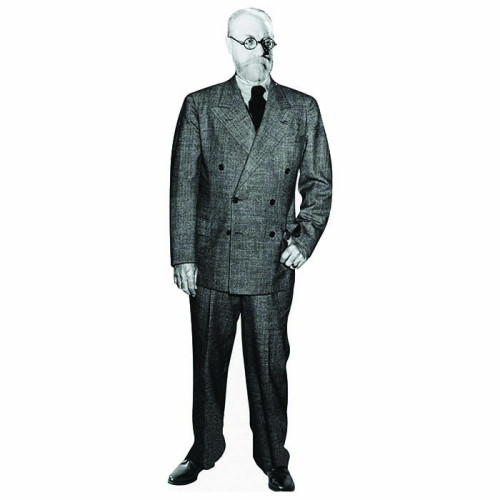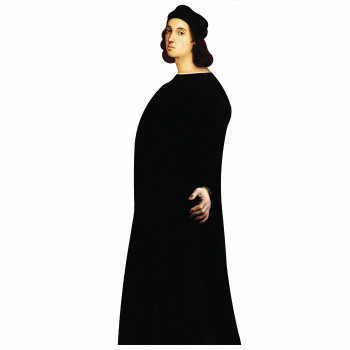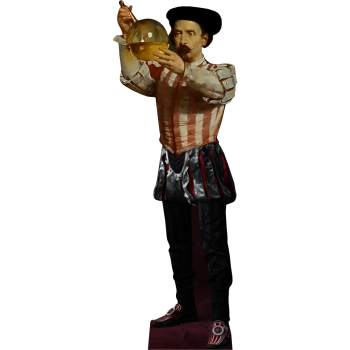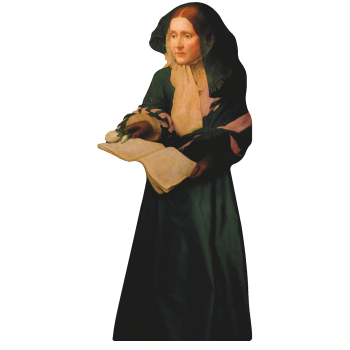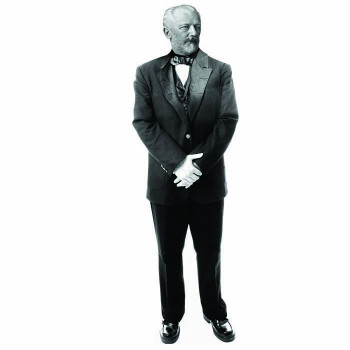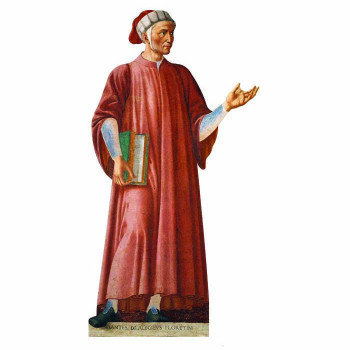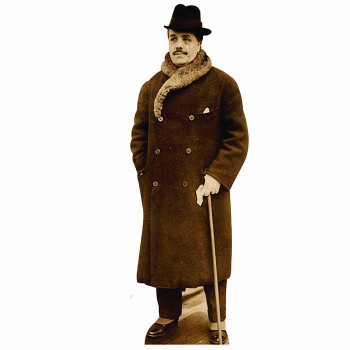HENRI MATISSE CARDBOARD CUTOUT
-
$0.00
Available Options
66 inches. Our cardboard cutout of Henri Matisse. All cardboard cutouts come folded and have an easel attached to the back to be self-standing. Items are printed and produced to order. Printing and processing takes up to 5 business days plus shipping time.
Introduction to Henri Matisse
Celebrate the legacy of one of the 20th century’s most influential artists with our lifesize cardboard cutout of Henri Matisse. Perfect for art displays, educational events, or as an inspiring addition to your home or office, this cutout captures the vibrant and dynamic presence of Henri Matisse, reflecting his profound impact on modern art and his innovative use of color and form.
Background of Henri Matisse
Henri Émile Benoît Matisse was born on December 31, 1869, in Le Cateau-Cambrésis, France. Initially pursuing a career in law, Matisse began painting in 1889 while recovering from an illness, finding his true passion in art. He studied at the Académie Julian and the École des Beaux-Arts in Paris, where he was influenced by Symbolist artists and Post-Impressionism.
Matisse’s early works were influenced by the Impressionists, but he soon developed his distinctive style characterized by bold colors, simplified forms, and expressive lines. In the early 1900s, he became a leading figure in the Fauvist movement, alongside André Derain. Fauvism, known for its vibrant, non-naturalistic colors and dynamic compositions, marked a significant departure from traditional representational art.
One of Matisse’s most famous works from this period is "Woman with a Hat" (1905), which caused a scandal at the Salon d'Automne but established him as a pioneer of modern art. His subsequent works, such as "The Dance" (1910) and "The Red Studio" (1911), further demonstrated his mastery of color and form.
Matisse continued to evolve as an artist, exploring various mediums including sculpture, printmaking, and drawing. In his later years, he turned to cut-outs, creating striking compositions by cutting shapes from painted paper. This technique culminated in works such as "The Snail" (1953) and "Blue Nude II" (1952), which are celebrated for their simplicity and vibrancy.
Despite health challenges, Matisse remained active in his later years, producing some of his most iconic works. He passed away on November 3, 1954, in Nice, France, leaving behind a rich legacy of innovation and creativity.
Cultural Impact of Henri Matisse
Henri Matisse’s impact on modern art is profound and enduring. As a pioneer of Fauvism, he challenged conventional approaches to color and composition, influencing generations of artists. His use of bold, expressive colors and simplified forms revolutionized painting and opened new possibilities for artistic expression.
Matisse’s work is celebrated for its joyous and vibrant qualities, often evoking a sense of freedom and movement. His ability to distill complex scenes into harmonious compositions of color and shape has made his art accessible and appealing to a wide audience.
The cut-out technique Matisse developed in his later years represents a significant innovation in modern art. These works, which combine elements of painting and sculpture, highlight his continuous exploration of new methods and his ability to adapt and innovate, even in the face of physical limitations.
Matisse’s influence extends beyond the visual arts to design, fashion, and architecture. His bold use of color and form has inspired numerous designers and architects, contributing to the development of modernist aesthetics.
Exhibitions of Matisse’s work continue to draw large audiences, and his paintings, sculptures, and cut-outs are held in major museums worldwide, including the Museum of Modern Art in New York, the Tate Modern in London, and the Centre Pompidou in Paris.
Henri Matisse’s legacy is celebrated through numerous retrospectives, publications, and educational programs, ensuring that his contributions to art are appreciated by future generations. His work remains a testament to the power of creativity and the transformative potential of art.
This cutout of Henri Matisse celebrates his remarkable contributions and enduring legacy as a master of modern art. It serves as a tribute to his artistic brilliance, his impact on the development of 20th-century art, and his significant role in shaping the visual culture of his time.
- Brand: Historical Cutouts
- Product Code:H79009
- Availability:In Stock
LEARN MORE ABOUT OUR AVAILABLE MATERIALS

LIFE SIZE HISTORICAL CUTOUTS
We have been the leading historical based cutout supplier for nearly 10 years. We have worked with many schools, museums, and colleges across the country to provide stunning graphics from hsitory. Historical Cutouts are available in 3 materials and come contour cut with an easel to be self standing. Click below to learn more about each material and our cutout process.
Learn More
LIFE SIZE HISTORICAL WALL DECALS
All of our historical figures are available as a life size wall decals. Vinyl wall decal orders come ready to apply with squeegie and instructions. Having trouble? Check out our how to youtube video. Our graphics are printed on tear resistant PhotoTex Vinyl using our high definition 4 color plus white printing process.
Learn More
HISTORICAL ACRYLIC CUTOUTS
Desktop Legends are a smaller version of our life size cutotus printed on 3/16th" acrylic. All of our historical cutouts are also available as a desktop legend. These acrylic statuettes come in two sizes, 8" and 12". If you would like to learn more please click below.
Learn MoreRELATED PRODUCTS
-
Raphael Sanzio Urbino Cardboard Cutout
72 inches. Our cardboard cutout of Raphael Sanzio Urbino. All cardboard cutouts come folded and have..
Alchemist William Fettes Douglas Painting Studying Arcane Knowledge Cardboard Cutout Standee Standup
25in x 72in Cardboard cutout of The Alchemist in the William Fettes Douglas painting. Alchemy is an ..
Julia Ward Howe Battle Hymn of the Republic Cardboard Cutout
Cardboard cutout of Julia Ward Howe. A very short lady, born May 27, 1819, Howe was an American auth..
Abbott Handerson Thayer Angel Painting
Cardboard cutout of Abbot Handerson Thayer's depiction of an Angel. Abbot was an American teacher, n..
Gustav Mahler Cardboard Cutout
70 x 36 inches. Our cardboard cutout of Gustav Mahler. All cardboard cutouts come folded and have an..
Henry James Cardboard Cutout
68 x 24 inches. Our cardboard cutout of Henry James. All cardboard cutouts come folded and have an e..
Old Bill Williams Rocky Mountains Trapper Mountain Man Men Hunter Blood Thunder Cardboard Cutout Standee Standup
82x47 inch cardboard cutout of Old Bill Williams, noted frontiersman, mountain man, and trapper. The..
Pyotr Ilyich Tchaikovsky Cardboard Cutout
66 x 20 inches. Our cardboard cutout of Pyotr Ilyich Tchaikovsky. All cardboard cutouts come folded ..
H79526 George Orwell 1984 Cardboard Cutout Standee Standup
74x30 inch cardboard cutout of George Orwell, the English novelist best known for his book 1984. The..
Detective Sherlock Holmes
75x37 inch cardboard cutout of Sherlock Holmes. As long as he?s supplied with ample amounts of coffe..
Dante Alighieri Cardboard Cutout
65 x 34 inches. Our cardboard cutout of Dante Alighieri. All cardboard cutouts come folded and have ..
Sergei Diaghilev Cardboard Cutout
72 x 25 inches. Our cardboard cutout of Sergei Diaghilev. All cardboard cutouts come folded and have..

